Magnitude and timing of leaf damage affect seed production in a natural population of Arabidopsis thaliana (Brassicaceae)
- PMID: 22276140
- PMCID: PMC3261866
- DOI: 10.1371/journal.pone.0030015
Magnitude and timing of leaf damage affect seed production in a natural population of Arabidopsis thaliana (Brassicaceae)
Abstract
Background: The effect of herbivory on plant fitness varies widely. Understanding the causes of this variation is of considerable interest because of its implications for plant population dynamics and trait evolution. We experimentally defoliated the annual herb Arabidopsis thaliana in a natural population in Sweden to test the hypotheses that (a) plant fitness decreases with increasing damage, (b) tolerance to defoliation is lower before flowering than during flowering, and (c) defoliation before flowering reduces number of seeds more strongly than defoliation during flowering, but the opposite is true for effects on seed size.
Methodology/principal findings: In a first experiment, between 0 and 75% of the leaf area was removed in May from plants that flowered or were about to start flowering. In a second experiment, 0, 25%, or 50% of the leaf area was removed from plants on one of two occasions, in mid April when plants were either in the vegetative rosette or bolting stage, or in mid May when plants were flowering. In the first experiment, seed production was negatively related to leaf area removed, and at the highest damage level, also mean seed size was reduced. In the second experiment, removal of 50% of the leaf area reduced seed production by 60% among plants defoliated early in the season at the vegetative rosettes, and by 22% among plants defoliated early in the season at the bolting stage, but did not reduce seed output of plants defoliated one month later. No seasonal shift in the effect of defoliation on seed size was detected.
Conclusions/significance: The results show that leaf damage may reduce the fitness of A. thaliana, and suggest that in this population leaf herbivores feeding on plants before flowering should exert stronger selection on defence traits than those feeding on plants during flowering, given similar damage levels.
Conflict of interest statement
Figures


Similar articles
-
Reduced seed viability in exchange for transgenerational plant protection in an endophyte-symbiotic grass: does the defensive mutualism concept pass the fitness test?Ann Bot. 2024 Dec 31;134(6):993-1002. doi: 10.1093/aob/mcae133. Ann Bot. 2024. PMID: 39132894 Free PMC article.
-
Inflorescence photosynthetic contribution to fitness releases Arabidopsis thaliana plants from trade-off constraints on early flowering.PLoS One. 2017 Oct 3;12(10):e0185835. doi: 10.1371/journal.pone.0185835. eCollection 2017. PLoS One. 2017. PMID: 28973036 Free PMC article.
-
Testing the optimal defense theory and the growth-differentiation balance hypothesis in Arabidopsis thaliana.Oecologia. 2005 Dec;146(2):169-78. doi: 10.1007/s00442-005-0207-0. Epub 2005 Oct 28. Oecologia. 2005. PMID: 16096848
-
Herbivory and natural selection on flowering phenology in wild sunflower, Helianthus annuus.Oecologia. 2000 Jan;122(1):72-82. doi: 10.1007/PL00008838. Oecologia. 2000. PMID: 28307959
-
Feeding damage to plants increases with plant size across 21 Brassicaceae species.Oecologia. 2015 Oct;179(2):455-66. doi: 10.1007/s00442-015-3353-z. Epub 2015 May 30. Oecologia. 2015. PMID: 26025575
Cited by
-
A nested reciprocal experimental design to map the genetic architecture of transgenerational phenotypic plasticity.Hortic Res. 2024 Jun 25;11(8):uhae172. doi: 10.1093/hr/uhae172. eCollection 2024 Aug. Hortic Res. 2024. PMID: 39108582 Free PMC article.
-
Priming of Arabidopsis resistance to herbivory by insect egg deposition depends on the plant's developmental stage.J Exp Bot. 2022 Aug 11;73(14):4996-5015. doi: 10.1093/jxb/erac199. J Exp Bot. 2022. PMID: 35522985 Free PMC article.
-
Grain amaranths are defoliation tolerant crop species capable of utilizing stem and root carbohydrate reserves to sustain vegetative and reproductive growth after leaf loss.PLoS One. 2013 Jul 4;8(7):e67879. doi: 10.1371/journal.pone.0067879. Print 2013. PLoS One. 2013. PMID: 23861825 Free PMC article.
-
Post-flowering biotic and abiotic stresses impact nitrogen use efficiency and seed filling in Arabidopsis thaliana.J Exp Bot. 2020 Jul 25;71(15):4578-4590. doi: 10.1093/jxb/eraa011. J Exp Bot. 2020. PMID: 31930315 Free PMC article.
-
Seasonal shift in timing of vernalization as an adaptation to extreme winter.Elife. 2015 Jul 23;4:e06620. doi: 10.7554/eLife.06620. Elife. 2015. PMID: 26203563 Free PMC article.
References
-
- Belsky AJ. Does herbivory benefit plants - a review of the evidence. Am Nat. 1986;127:870–892.
-
- Stowe KA, Marquis RJ, Hochwender CG, Simms EL. The evolutionary ecology of tolerance to consumer damage. Annu Rev Ecol Syst. 2000;31:565–595.
-
- Rausher MD. Co-evolution and plant resistance to natural enemies. Nature. 2001;411:857–864. - PubMed
-
- Núñez-Farfán J, Fornoni J, Valverde PL. The evolution of resistance and tolerance to herbivores. AnnuRev Ecol Evol Syst. 2007;38:541–566.
Publication types
MeSH terms
LinkOut - more resources
Full Text Sources
Miscellaneous

